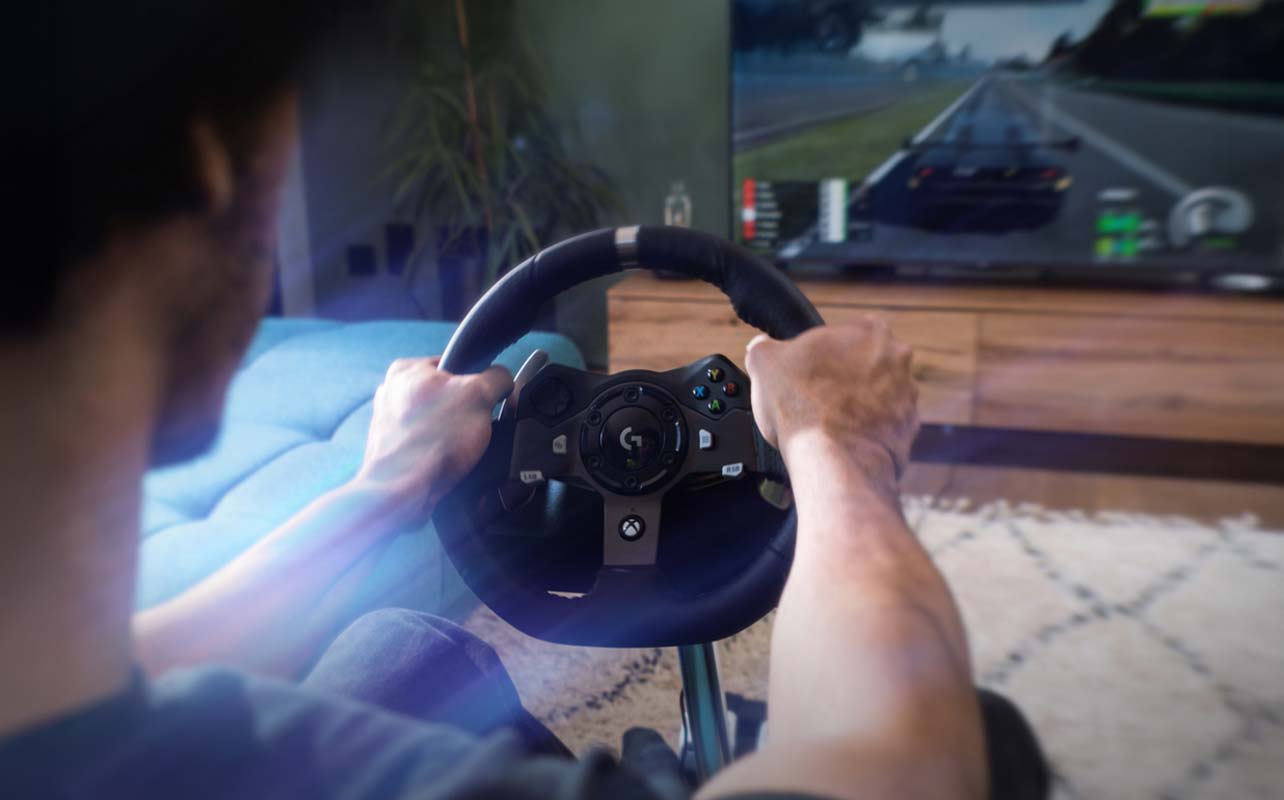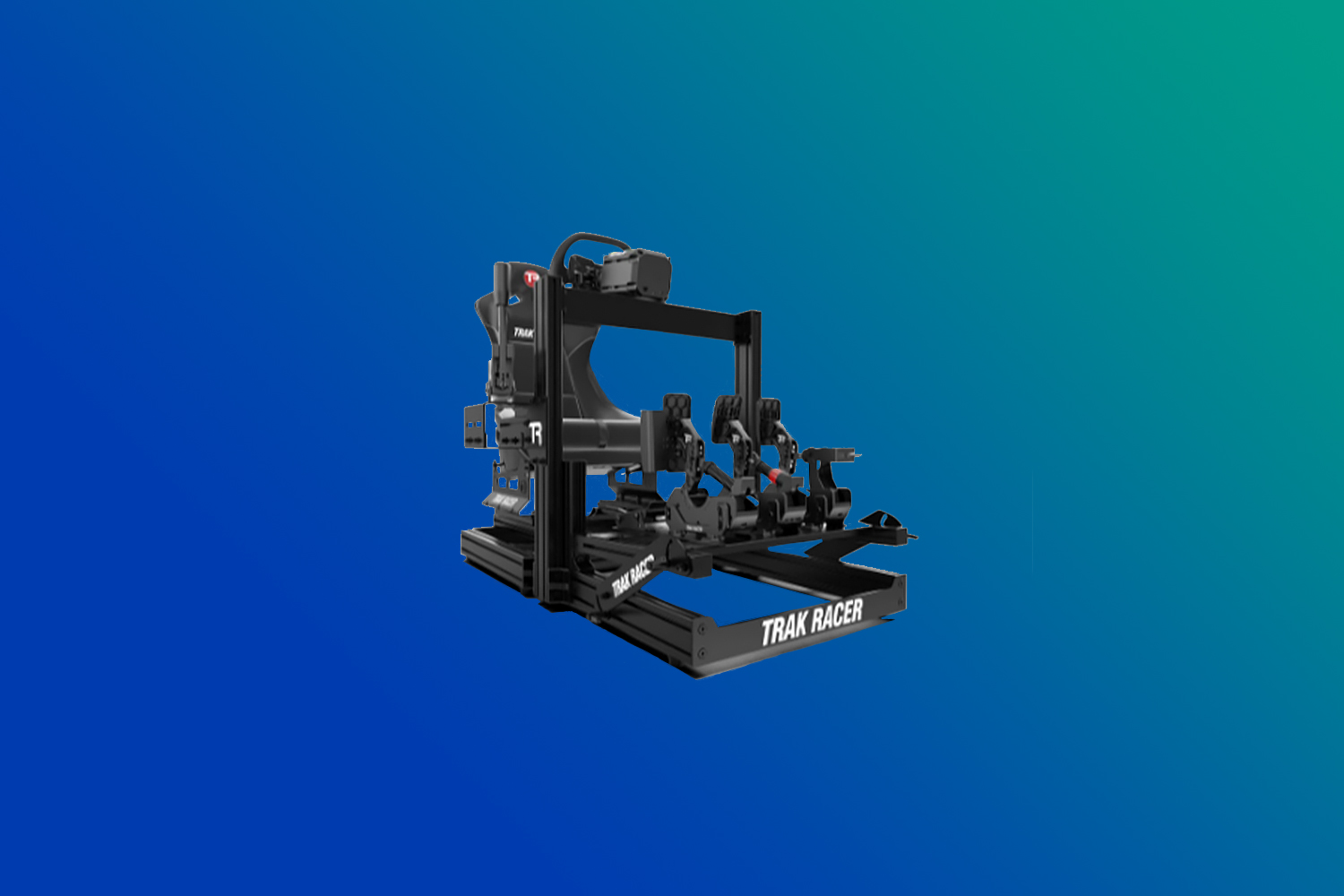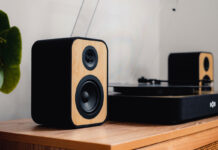
Today, simulation gaming has never felt more real. Racing and flight simulator rigs have exploded in popularity—hardware is more affordable, software is smarter, and content creators have turned their setups into full-blown experiences. If you’re ready to step into the world of simulation, you might ask what kind of setup should you buy. The three main categories are wheel stands, cockpit rigs, and full simulator rigs. Each offers different levels of immersion, comfort, and price.
Which one is the perfect racing sim setup for you? Let’s break them down.
Wheel stands (budget-friendly & space-saving)
A wheel stand is the simplest type of simulator setup. This no-fuss metal stand holds your flight controller, racing wheel and pedals—nothing more, nothing less. No built-in seat, no frame. Set it up in front of your TV or desk, pull up your chair, and you’re ready to hit the virtual track. When you’re done, it folds up neatly and disappears behind a couch or under your bed.

Wheel stands are perfect for anyone dipping their toes into sim racing or flight simulation. They’re affordable, portable, and flexible enough to use anywhere—your living room, dorm, or office.
Pros and cons of a wheel stand
| Pros: | Cons: |
| • Affordable, usually in the $100–$250 range | • Less immersive—you’re not locked into a driver’s position |
| • Foldable or compact enough to tuck away when not in use | • Can slide or shift during intense racing sessions |
| • Works with virtually any chair in your house | • You have to provide your own seating (an old office chair may not cut it for long races) |
Best for: Occasional racers, console gamers, or anyone who wants the best sim rig for beginners without committing too much space or cash. If you’re searching for a sim rig for small space, a wheel stand is the most practical option.
Cockpit rigs (immersive mid-tier experience)
Simulator cockpits and seats take things up a notch. This mid-tier option includes a dedicated racing seat and a sturdy frame that holds your wheel, pedals, shifter, and even flight controls.

You get a fixed seat attached to a frame that holds your wheel, pedals, shifter, or even a flight yoke and throttle quadrant. Imagine buckling yourself into a padded seat, gripping the wheel, and feeling the resistance of a sturdy frame as you take a sharp corner. It’s a setup that instantly elevates the experience from casual to immersive as you fly through digital clouds.
Cockpit rigs strike a great balance between immersion and practicality. They’re sturdy enough to handle force feedback from racing wheels, and comfortable enough for long sessions. Many cockpit rigs are modular, meaning you can upgrade over time—add a monitor mount, flight stick, and other racing or flight simulator accessories down the line.
Pros and cons of a cockpit rig
| Pros | Cons |
| • Much more immersive than a wheel stand | • Larger footprint than a wheel stand—some models need a dedicated corner of your room |
| • Stable and comfortable, even during multi-hour sessions | • Fixed seats mean less flexibility if space is tight |
| • Modular and easy to upgrade with accessories | • Price typically ranges $300–$800+ |
Best for: Players who know they’ll be in it for the long haul. If you’re serious about sim racing or you want a dedicated flight simulator rig, the cockpit is often the sweet spot. It’s realistic, upgrade-friendly, and won’t swallow up your entire budget.
Full simulator rigs (the premium setup)
This is the dream. A full simulator rig transforms your room into a cockpit or race bay. These are the setups you see on Twitch streams or in professional training environments.
Prepare for a full immersive experience, three screens wrap around you, the racing-style seat vibrates as the car roars to life, and when you hit the brakes, the whole rig tilts forward. You don’t just play a racing or flight game—you feel it. This is the category where the term “sim rig” takes on its full meaning.
Pros and cons of a full simulator rig
| Pros | Cons |
| • Unmatched immersion, especially with motion feedback, surround sound, and multi-monitor setups | • Expensive, typically $1,000–$3,000 or more once you factor in extras |
| • Built with professional-grade materials and modular for upgrades | • Requires dedicated space—these rigs are not foldable or easy to move |
| • Designed for long-term use and serious performance | • Assembly can be complicated, especially with motion add-ons |
Best for: Many pro sim racers, streamers, and aviation trainees use the full simulator rig. They’re the pinnacle of immersion and performance—and yes, they demand both space and a healthy budget.
Wheel stand vs cockpit vs full rig—what’s right for you?
It helps to see these options side by side. Here’s a quick breakdown:
| User type | Recommended setup | Why it works |
| Casual gamer | Wheel stand | Compact, easy to store, and affordable entry point for beginners. |
| Apartment or small space | Wheel stand or compact cockpit | Foldable and practical for tight living spaces. |
| Aspiring sim racer | Cockpit rig | Offers the best balance between realism and cost. |
| Flight sim hobbyist | Cockpit or full rig | Provides better control support and comfort during long sessions. |
| Competitive eRacer | Full rig | Delivers low-latency response and maximum immersion for competitive play. |
| Streamer or content creator | Full rig | Looks professional on camera and enhances viewer experience. |
Think of it as mapping your gamer profile to your rig. If you’re a casual console player in a one-bedroom apartment, you might not like having a massive frame in your living room. On the other hand, if you’re training for competitive iRacing events, a basic wheel stand won’t cut it.
Key considerations before hitting the gas on a new setup
Beyond the type of rig, these factors can make or break your experience.
Flight vs. racing use
If you love flight sims, look for rigs that can accommodate mounts for a yoke, throttle quadrant, or flight stick. Some rigs are modular and can handle both racing and flight gear, which saves money and keeps your setup versatile. Considering this early ensures your rig grows with your interests.
Cross-platform compatibility
Make sure your rig supports the hardware you’re using. Some are optimized for PC, while others work best with consoles like PlayStation or Xbox. Double-check compatibility before buying—doing so will prevent frustration and help you get the most out of your gear.
Upgrade path
Many cockpit and full rigs let you start small and expand over time. You can add a shifter mount, triple-monitor stand, or even a motion platform later on. Choosing an upgradable rig is smart if you want to future-proof your setup without starting from scratch.
Ergonomics
Comfort is everything in sim racing and flight simulation. Look for adjustable seats, pedal distances, and wheel heights to reduce fatigue during long sessions. A properly fitted setup can turn a fun hour of racing into an all-evening marathon without discomfort.
Build quality
Powder-coated steel, aluminium profiles, and secure mounting points are signs of a quality rig. Lower-end builds can flex or wobble, which breaks immersion and shortens the lifespan of your hardware. Investing in solid materials ensures stability and smoother gameplay.
Find the perfect racing sim setup for you
Simulation setups are a high-consideration purchase, but they can transform gaming into a fully immersive experience. If you’re exploring your options in racing sim setup, check out our selection of sim rigs at Best Buy Canada. Compare builds and find the setup that matches your style.
This article was drafted using AI technology and then reviewed, fact-checked, and revised by a member of our editorial team.





